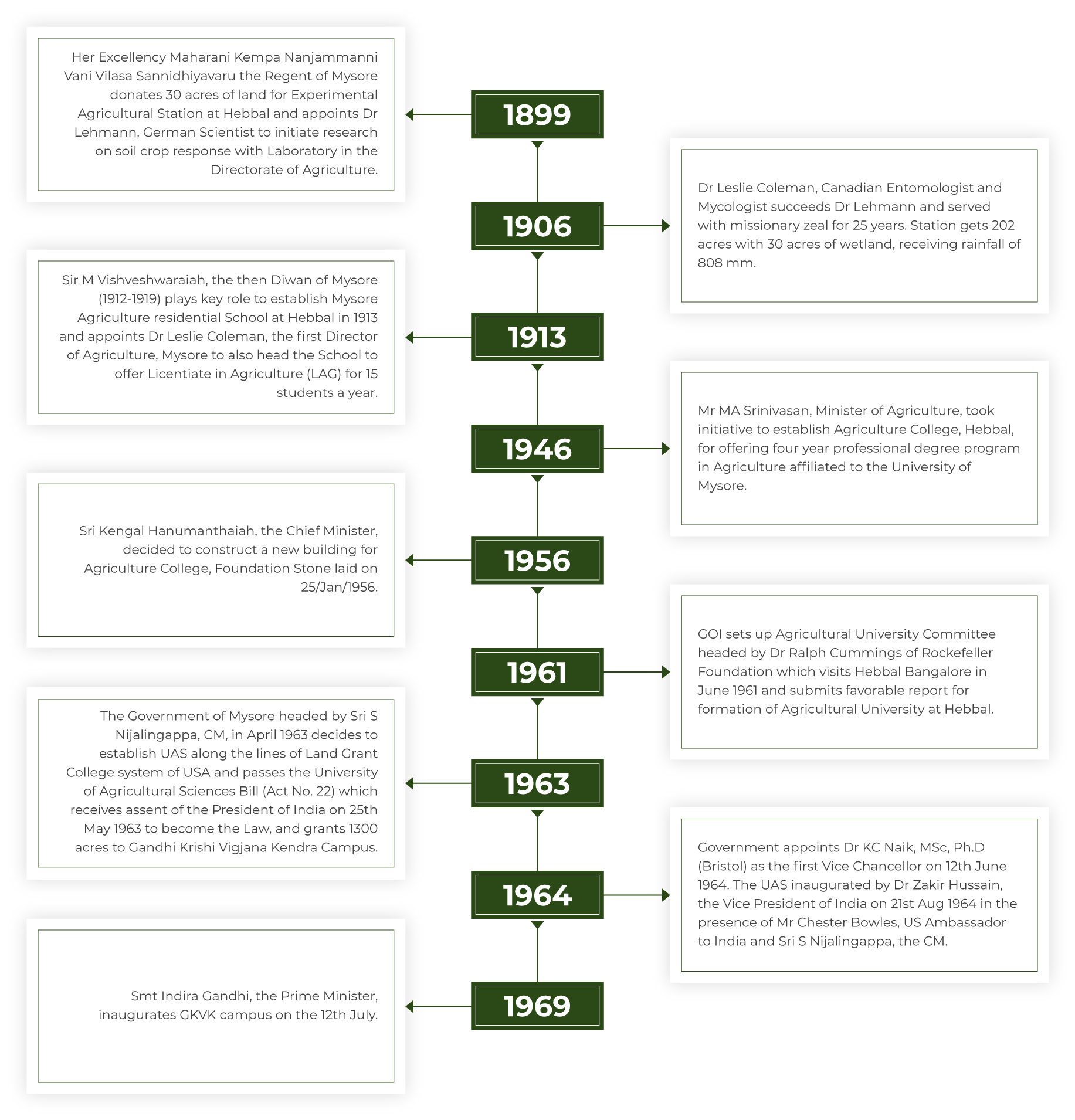

The University of Agricultural Sciences, Bangalore (UASB) was the first State Agricultural University (SAU) in Karnataka established in 1963 through an act of the Legislature of the then Mysore State on the pattern of the U.S. Land Grant System and inaugurated by Dr. Zakir Hussain, Vice-President of India on August 21, 1964. Originally, an experimental farm of 30 acres was established at Hebbal in 1899 which was upgraded to an Agricultural School in 1913 and later into Mysore Agricultural College in 1946. In 1958, Veterinary College, Hebbal was established. Later the University has established on October 1, 1965, the Colleges of Agriculture with campuses at Hebbal, Bangalore and Dharwad. The Gandhi Krishi Vignana Kendra (GKVK) campus with an area of 1320 acres was inaugurated by Smt. Indira Gandhi, then Prime Minister of India on July 12, 1969, and the GKVK is a biodiversity hotspot, therefore the campus was declared as Bio-Heritage Site during 2009.
The University established the Fisheries College at Mangalore in 1969 to offer Bachelor of Fisheries Science training and the Agricultural Engineering Institute at Raichur to offer a three-year diploma in Agricultural Engineering. In 1974, Home Science College was started to impart education in Rural Home Science at Dharwad Campus, besides establishing a College of Basic Sciences and Humanities and the College of Post Graduate Studies at Hebbal. The degree programme on B.Sc. (Agricultural Marketing and Co-operation), the first of its kind in the country, was started during the academic year 1976-77 by the University of Agricultural Sciences, Bangalore, at two campuses, namely, Bangalore and Dharwad. College of Forestry, Sirsi was established in the year 1985.
The phenomenal growth of the University, the differences in agro-climate in the parts of the state, led to the bifurcation of the University into two agricultural universities. An amendment to the University of Agricultural Sciences Act in 1986 saw the birth of the second University for agriculture in the state. The University of Agricultural Sciences, Bangalore was entrusted territorial jurisdiction over 15 southern districts of Karnataka comprising nearly fifty per cent of the total area of the state, while the University of Agricultural Sciences, Dharwad, was given jurisdiction over the remaining area in the northern districts of the state.
In 2005, with the need to provide better autonomy to the veterinary education and research in the state, the Veterinary and Animal Sciences was bifurcated from both the Universities of Agricultural Sciences, Bangalore and Dharwad and placed under the single University – Karnataka Veterinary, Animal and Fisheries Sciences University with its headquarters in the northern district of Karnataka, Bidar by passing the Karnataka Veterinary, Animal and Fisheries Sciences University Bill, 2004 in the Legislative Assembly on 10 February 2004.
Realising the importance and foresightedness of the Karnataka Government, His Excellency, the Governor of Karnataka has approved the establishment of the University of Horticultural Sciences (UHS) at Bagalkot through a special Ordinance No 2 of 2008 dated: 22-11-2008, bifurcated from both the Universities of Agricultural Sciences, Bangalore and Dharwad and placed under the single University.
In the year 2012, University of Agricultural and Horticultural Sciences, Shivamogga was established under Karnataka Act No. 38 of 2012 by separating seven districts from the jurisdictional area of the University of Agricultural Sciences, Bangalore. Presently, the University covering with broad geographic area spread in different regions/jurisdiction covering 10 districts of Karnataka State.
Vision 2030
The agriculture sector warrants a paradigm shift in academics, research, and outreach approaches. The future thrust would be on streamlining agricultural education to impart quality education and to encompass frontier sciences to develop a new band of agricultural scientists who are globally competitive. The teaching-learning process will be touched with modern innovative practical skill-based methods. Curricula will be made globally competitive and locally relevant.
b) The University has statutory responsibility for furthering the advancement of learning and research, particularly in agriculture and other allied sciences. The University recognizes the need for
intensification of the research and development of roadmap, and bringing in structural change in the Institutional Research & Development framework and functions in respect of Agro-climatic Zones with new mechanisms to achieve inclusive growth. In this endeavour, the University promotes a consortia mode of research with emphasis on the PPP mode.
c) Priority shall be to enhance the University to reach the unreached and harness the benefits of new technologies. In this regard, component convergence for comprehensive community development shall be the set agenda.
Goals
The goal is set towards sustainable development, and our programmes must be planned to achieve food and nutritional security. With the available knowledge on cutting-edge technologies,
interdisciplinary approaches and human resources, it must be possible to enhance production to accomplish food security. Our research and developmental activities shall not only result in food
security but will also provide nutritional security too. In addition, there must be systems to manage, to minimize the post-harvest losses and maximize the produce. Development of a network between
producers, markets and consumers is yet a challenging task. The betterment of this system contributes to the unreached. Our university has the responsibility of moulding our graduates to think critically about contributing to the rural society, as well as the Nation and even at the global level, towards maximizing food production. In precise, Learn, Earn and Return. Advanced technologies should be brought out and promoted by building a knowledge base among scientific faculty. The University is striving to adopt a dynamic finance system to provide better governance for accounting and monitoring for overall development to bring a paradigm shift in the agricultural production system.
Objectives / Future Focus
1) To establish a dynamic system of agricultural education to train highly skilled and competent
manpower
2) To modernize infrastructure like laboratories, farmlands and operational research
management system
3) To strengthen targeted crop improvement programmes (editing, genomics aided crop
improvement, etc.)
4) To develop Climate Smart Adaptive Agriculture Technologies
5) Applications of Drones, Robotics and AI/ ML in agriculture
6) Develop innovative outreach systems for knowledge transfer
7) To establish Agri.-Tourism, Eco-Tourism
8) E-governance/administration as a green initiative
9) Collaboration with leading Universities / Institutions at the National and International levels to upgrade the skills
10) Upgradation of automation of UG / PG academic activities
11) E-feedback mechanism from students towards quality improvement in teaching
12) Branding and popularization of value-added products in diversified fields and helping in patenting
13) Development of farmer’s friendly ‘Apps’ in Kannada
- 1899: Her Excellency Maharani Kempa Nanjammanni Vani Vilasa Sannidhiyavaru the Regent of Mysore donates 30 acres of land for Experimental Agricultural Station at Hebbal and appoints Dr Lehmann, German Scientist to initiate research on soil crop response with Laboratory in the Directorate of Agriculture.
- 1906: Dr Leslie Coleman, Canadian Entomologist and Mycologist succeeds Dr Lehmann and served with missionary zeal for 25 years. Station gets 202 acres with 30 acres of wetland, receiving rainfall of 808 mm.
- 1913: Sir M Vishveshwaraiah, the then Diwan of Mysore (1912-1919) plays key role to establish Mysore Agriculture residential School at Hebbal in 1913 and appoints Dr Leslie Coleman, the first Director of Agriculture, Mysore to also head the School to offer Licentiate in Agriculture (LAG) for 15 students a year.
- 1946: Mr MA Srinivasan, Minister of Agriculture, took initiative to establish Agriculture College, Hebbal, for offering four year professional degree program in Agriculture affiliated to the University of Mysore.
- 1956: Sri Kengal Hanumanthaiah, the Chief Minister, decided to construct a new building for Agriculture College, Foundation Stone laid on 25/Jan/1956.
- 1961: GOI sets up Agricultural University Committee headed by Dr Ralph Cummings of Rockefeller Foundation which visits Hebbal Bangalore in June 1961 and submits favorable report for formation of Agricultural University at Hebbal.
- 1963: The Government of Mysore headed by Sri S Nijalingappa, CM, in April 1963 decides to establish UAS along the lines of Land Grant College system of USA and passes the University of Agricultural Sciences Bill (Act No. 22) which receives assent of the President of India on 25th May 1963 to become the Law, and grants 1300 acres to Gandhi Krishi Vigjana Kendra Campus.
- 1964: Government appoints Dr KC Naik, MSc, Ph.D (Bristol) as the first Vice Chancellor on 12th June 1964. The UAS inaugurated by Dr Zakir Hussain, the Vice President of India on 21st Aug 1964 in the presence of Mr Chester Bowles, US Ambassador to India and Sri S Nijalingappa, the CM.
- 1969: Smt Indira Gandhi, the Prime Minister, inaugurates GKVK campus on the 12th July.
GOVERNANCE
 The University of Agricultural Sciences, Bangalore currently has administrative headquarters at the Gandhi Krishi Vigyan Kendra (GKVK), Bengaluru. Presently, the University has six constituent Colleges with 19 Departments, one Main Research Station (MRS), two Zonal Agricultural Research Stations (ZARS), nine Agricultural Research Stations (ARS) and seven Krishi Vigyan Kendras (KVKs)
The University of Agricultural Sciences, Bangalore currently has administrative headquarters at the Gandhi Krishi Vigyan Kendra (GKVK), Bengaluru. Presently, the University has six constituent Colleges with 19 Departments, one Main Research Station (MRS), two Zonal Agricultural Research Stations (ZARS), nine Agricultural Research Stations (ARS) and seven Krishi Vigyan Kendras (KVKs)

-
- Page Visitors Count:
- Last Updated: March 19, 2025
- Site Statistics





